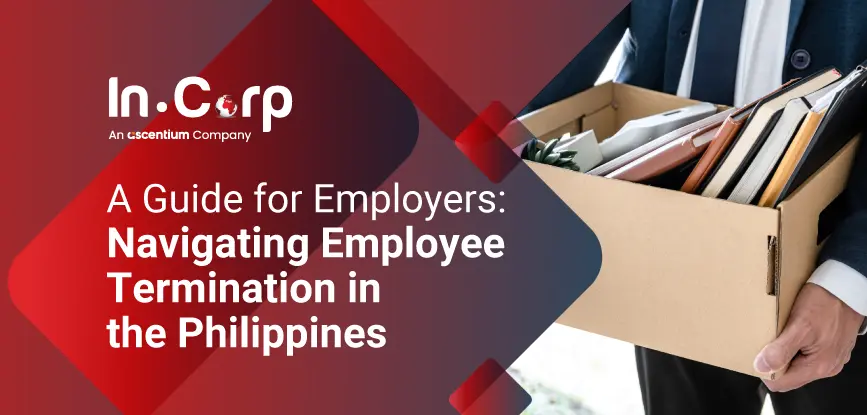
A Guide for Employers: Navigating Employee Termination in the Philippines
Employee termination is a significant responsibility for any employer. In the Philippines, the process is regulated by labor laws that protect employees from unjust dismissal. Failure to follow legal procedures can result in costly disputes, reputational damage, and diminished morale. Adherence to these laws is essential for compliance and maintaining a fair and respectful workplace.
- What are the Lawful Basis for Termination in the Philippines?
- Just Causes for Termination
- Authorized Causes for Termination
- What are the Procedural Requirements for Authorized Causes?
- How to Ensure Procedural Due Process?
- What Types of Compensation Are Due Upon Termination?
- Frequently Asked Questions
What are the Lawful Basis for Termination in the Philippines?
The Labor Code of the Philippines recognizes two primary categories of lawful termination: Just Causes and Authorized Causes. Below is a concise distinction between the two:
- Just Causes. Terminations based on the employee’s fault or misconduct, these include:
- Serious misconduct or willful disobedience: Intentional disregard of lawful, reasonable directives related to the employee’s duties; the misconduct must be grave.
- Gross and habitual neglect of duties: Repeated and significant failure to perform job responsibilities; isolated minor lapses generally do not suffice.
- Fraud or willful breach of trust: Particularly applicable to positions of trust and confidence; the act must relate to work, and loss of trust must be substantiated.
- Commission of a crime: Offenses committed against the employer, the employer’s immediate family, or duly authorized representatives.
- Analogous causes: Comparable offenses such as gross inefficiency or persistent poor performance amounting to neglect.
- Authorized Causes. Terminations not due to the employee’s fault, arising from legitimate business or health reasons such as:
- Installation of labor-saving devices: Introduction of technology that renders a position unnecessary.
- Redundancy: Roles exceeding the company’s reasonable requirements.
- Retrenchment to prevent losses: Downsizing to avert or reduce substantial, proven business losses.
- Closure or cessation of operations: Partial or complete shutdown not intended to circumvent labor laws.
- Disease or illness: A condition that legally prohibits continued work or endangers the employee or coworkers, supported by certification from a competent public health authority.
What are the Procedural Requirements for Authorized Causes?
Terminations on the basis of authorized causes follow a distinct yet equally critical procedure.
- Written Notice
- The employer shall provide written notice of termination to both the affected employee and the Department of Labor and Employment (DOLE) at least thirty (30) days prior to the effectivity of the employment termination.
- Separation Pay
- Employees terminated for authorized causes are entitled to separation pay, computed as follows:
- Installation of labor-saving devices or redundancy: One (1) month pay, or at least one (1) month pay for every year of service, whichever is higher.
- Retrenchment, closure, or disease: One (1) month pay, or at least one-half (1/2) month pay for every year of service, whichever is higher.
**Note: For computation purposes, a fraction of at least six (6) months is generally considered as one (1) full year of service.
How to Ensure Procedural Due Process?
For terminations based on just causes, employers must strictly observe the “two-notice rule” to satisfy procedural due process.
- First Notice (Notice to Explain)
- The employer shall issue a written notice specifying the particular grounds for possible termination, citing the company rules or policies allegedly violated and or any valid grounds under Article 297 (Termination by Employer). The employee must be given a reasonable period to submit a written explanation, typically within five (5) calendar days.
- Ample Opportunity to be Heard
- After receiving the employee’s explanation, the employer should conduct a hearing or conference to allow the employee to respond to the charges, present evidence, and confront witnesses, if any. The employee may be assisted by a representative or counsel.
- Second Notice (Notice of Decision)
- Upon completion of a thorough investigation and if just cause is established, the employer shall issue a second written notice informing the employee of the final decision to terminate, including the specific factual and legal grounds supporting the decision.
What Types of Compensation Are Due Upon Termination?
There are two compensation components typically due upon termination in the Philippines: separation pay (when applicable) and final pay.
- Separation pay. It is a form of compensation granted to employees terminated for authorized causes, indicating that the separation was not due to the employee’s fault. It recognizes the involuntary nature of the separation and is intended to provide financial support during the transition period.
- Final pay. Refers to the total wages and other entitlements that become due upon the end of employment. This typically includes pro-rated salary for days worked up to the effective date of resignation or termination, along with any other payable benefits in accordance with law, company policy, or applicable agreements.
Understand Employee Termination in the Philippines
Frequently Asked Questions
What is the difference between just and authorized causes for termination?
Just causes arise from employee fault, like serious misconduct or willful disobedience. Authorized causes stem from business reasons, such as redundancy, retrenchment, or closure. Procedures and compensation differ for each.
What notice is required for termination due to authorized causes?
For authorized causes such as redundancy or retrenchment, give written notice to the employee and DOLE at least 30 days before effectivity. This ensures proper notice to all parties.
What is the "two-notice rule" for just-cause terminations?
This rule ensures due process. First, issue a written Notice to Explain detailing the charges and giving time to respond. After a fair hearing, if dismissal is warranted, issue a written Notice of Decision stating the grounds.


